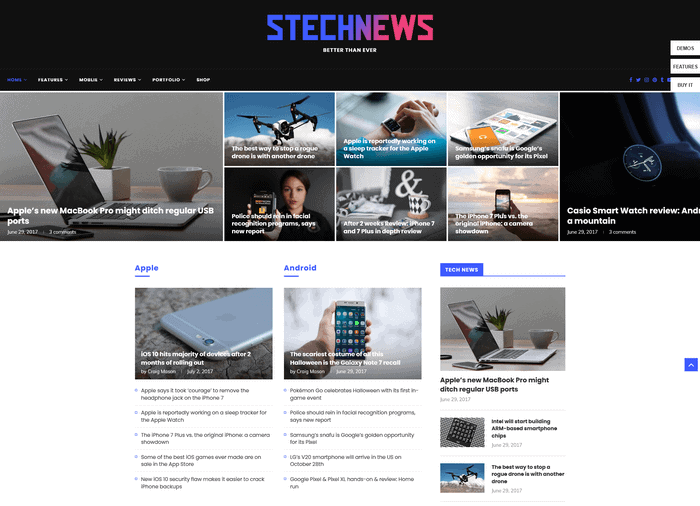How the Best tech blog Keeps You Upgraded on Cutting-Edge Gadgets and Software
Comprehending the Rise of Edge Computer in Today's Digital Globe
In the swiftly developing landscape of technology, side computing arises as a critical force, reshaping how data is processed and used. This standard shift is driven by the expansion of IoT gadgets and an escalating demand for instantaneous data processing. By transitioning information monitoring closer to the source, side computer addresses crucial latency concerns while maximizing data transfer use and enhancing protection actions. As markets pivot towards smarter, extra effective systems, recognizing the nuances and implications of this technical advancement ends up being imperative. What does this mean for future innovations and the digital environment in its entirety?
What Is Edge Computer
Edge computer, although a relatively current innovation in the world of technology, basically transforms exactly how data is processed and handled by bringing calculation and information storage space closer to the place where it is required. Unlike typical cloud computer versions, which usually rely upon centralized data centers that can be geographically distant, side computer decentralizes data handling. This proximity minimizes latency, boosts real-time information handling, and enhances the general individual experience by making sure much faster action times.
At its core, side computing involves a network of local gadgets and infrastructure, such as sensors, routers, and entrances, efficient in refining data at or near the resource. This local processing capability is especially important for applications calling for instant information evaluation, such as independent automobiles, commercial automation, and smart cities. Additionally, by unloading data processing tasks from main web servers, edge computing reduces data transfer requirements and boosts information privacy and safety, as sensitive information can remain on-site as opposed to going across extensive networks.

Secret Chauffeurs of Adoption
Several factors are thrusting the adoption of edge computer in today's electronic landscape. One of the primary drivers is the rapid increase in linked gadgets, frequently referred to as the Web of Points (IoT) This surge produces substantial quantities of information that require to be refined swiftly and successfully. Edge calculating addresses this demand by enabling data processing closer to the data resource, reducing latency and boosting real-time decision-making abilities.
An additional substantial chauffeur is the demand for improved transmission capacity effectiveness. Centralized cloud systems can end up being overloaded with the large volume of information created by IoT tools, resulting in bottlenecks (Best tech blog). By refining data at the side, organizations can alleviate network blockage and improve total system efficiency
Additionally, protection and privacy concerns are pressing companies towards side computing. By processing delicate data locally, companies can alleviate risks connected with information transmission and direct exposure to possible cyber dangers.
The increase of applications requiring real-time handling, such as independent lorries and enhanced reality, likewise demands the quick feedback times that edge calculating offers. Collectively, these vehicle drivers are making edge calculating an important component of modern-day IT framework, leading the means for its extensive adoption throughout numerous industries.
Advantages Over Cloud Computer
Just how does edge computing distinguish itself from traditional cloud computer? Primarily, edge computing brings information handling closer to the source of information generation, typically on local tools or nearby web servers, as opposed to depending on central information facilities. This proximity substantially minimizes latency, enabling real-time information handling and decision-making. For industries where nanoseconds issue, such as independent vehicles or commercial automation, the minimized latency offered by edge computer can be critical.
Moreover, edge computer improves data transfer performance (Best tech blog). By processing data in your area, just the essential data is transmitted to the cloud for more evaluation or storage, decreasing the quantity of data that goes across the network. This not just eases network blockage but likewise decreases information transmission prices
Edge computing additionally provides better information personal privacy and security. Delicate data can be processed locally without being sent to the cloud, reducing the direct exposure to prospective cyber risks. This is particularly beneficial for fields dealing with confidential info, such as healthcare and financial services.
In addition, side computer makes sure higher strength and dependability. Neighborhood processing enables proceeded operation also when connectivity to the cloud is jeopardized, preserving necessary functions and services in spite of possible network disruptions. These benefits jointly show edge computing's transformative possibility in optimizing performance and safety in digital ecological communities.
Considerations and challenges
While side computing supplies many advantages, it also provides special challenges and considerations that should be addressed to completely realize its capacity. Furthermore, managing and checking a decentralized network of edge tools can be complex, needing sophisticated tools and approaches to make certain smooth operation and maintenance. Best tech blog.
An additional factor to consider is the scalability of side computing solutions. As the number of connected gadgets grows, so does the demand for processing power at the side, which can lead to source constraints. Organizations has to meticulously plan their facilities to suit this development without compromising performance or performance.
Interoperability is an additional vital element. With numerous hardware and software program parts involved, making sure compatibility and seamless integration can be tough. Standardization efforts are necessary to assist in communication between disparate systems.
Future Patterns in Edge Computing
Anticipating the future, side computing is poised to view it now transform numerous markets by making it possible for much faster information handling and lowering latency. As the volume of data produced by IoT gadgets continues to grow, edge computer will certainly come to be progressively vital in handling this influx efficiently.
An additional emerging pattern is the advancement of edge-native applications created particularly to leverage the special abilities of edge computer. These applications will certainly optimize performance and source usage, leading to raised efficiency throughout various fields. Developments in 5G technology will even more boost side computing by offering the required facilities for high-speed, low-latency communication in between tools and side nodes.
Verdict
Side computer's surge is driven by the proliferation of IoT gadgets and pop over to this web-site the need for real-time data processing, which boosts efficiency by lowering latency and decentralizing information monitoring. This technique minimizes data transfer ineffectiveness and security concerns, facilitating improvements in applications like smart cities and autonomous cars. In spite of difficulties such as infrastructure complexity and combination, the future of side computing guarantees an extra responsive digital ecological community, with proceeded technologies shaping its development and broadening its applicability across markets.
Edge computing, although a relatively recent innovation in the world of modern technology, fundamentally transforms just how information is refined and managed by bringing computation and data storage space closer to the area where it is required. Unlike standard cloud computing versions, which commonly depend on centralized information facilities that can be geographically far-off, edge computer decentralizes information handling. In addition, by offloading data processing jobs from central servers, edge computing minimizes transmission capacity requirements and improves data privacy and protection, as sensitive information can remain go to website on-site rather than passing through comprehensive networks.
